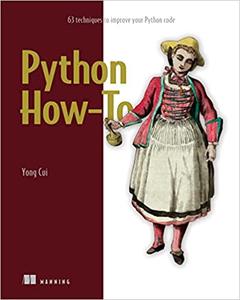
Free Download Python How-To
by Yong Cui
English | 2023 | ISBN: 161729974X | 506 pages | True PDF | 12.71 MB
Have you ever asked yourself, "How do I do that in Python?" If so, you'll love this practical collection of the most important Python techniques.
Python How-To includes over 60 detailed answers to questions
...and much more
Python How-To walks you through the most important coding techniques in Python. Whether you're doing data science, building web applications, or writing admin scripts, you'll find answers to your "how-to" questions in this book. Inside you'll find important insights into both Python basics and deep-dive topics to help you skill-up at any stage of your Python career. Author Yong Cui's clear and practical writing is instantly accessible and makes it easy to take advantage of Python's versatile tools and libraries. Perfect to be read both from cover to cover, and whenever you need help troubleshooting your code.
Purchase of the print book includes a free eBook in PDF, Kindle, and ePub formats from Manning Publications.
About the Technology
Python How-To uses a simple but powerful method to lock in 63 core Python skills. You'll start with a question, like "How do I find items in a sequence?" Next, you'll see an example showing the basic solution in crystal-clear code. You'll then explore interesting variations, such as finding substrings or identifying custom classes. Finally, you'll practice with a challenge exercise before moving on to the next How-To.
About the Book
This practical guide covers all the language features you'll need to get up and running with Python. As you go, you'll explore best practices for writing great Python code. Practical suggestions and engaging graphics make each important technique come to life. Author Yong Cui's careful cross-referencing reveals how you can reuse features and concepts in different contexts.
What's Inside
How
...and much more.
About the Reader
For beginning to intermediate Python programmers.
About the Author
Dr. Yong Cui has been working with Python in bioscience for data analysis, machine learning, and tool development for over 15 years.
Table of Contents
1 Developing a pragmatic learning strategy
PART 1 - USING BUILT-IN DATA MODELS
2 Processing and formatting strings
3 Using built-in data containers
4 Dealing with sequence data
5 Iterables and iterations
PART 2 - DEFINING FUNCTIONS
6 Defining user-friendly functions
7 Using functions beyond the basics
PART 3 - DEFINING CLASSES
8 Defining user-friendly classes
9 Using classes beyond the basics
PART 4 - MANIPULATING OBJECTS AND FILES
10 Fundamentals of objects
11 Dealing with files
PART 5 - SAFEGUARDING THE CODEBASE
12 Logging and exception handling
13 Debugging and testing
PART 6 - BUILDING A WEB APP
14 Completing a real project
